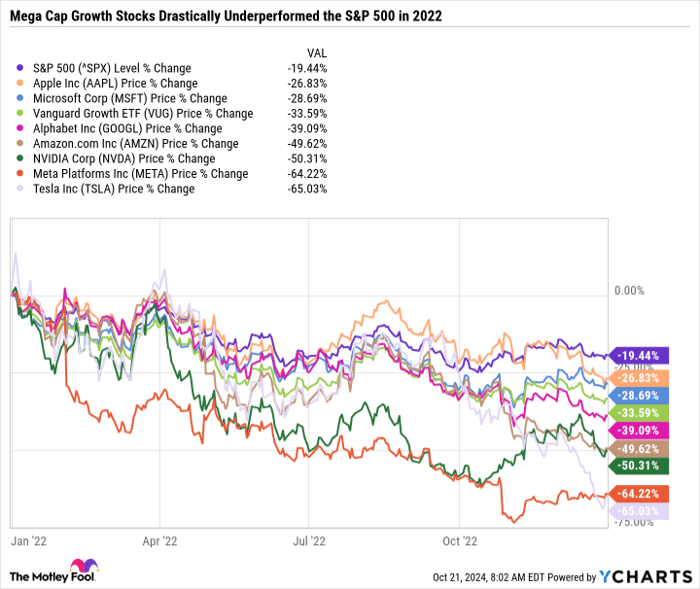In a whirlwind of a mere two-year span, the triumvirate of market giants comprising Nvidia (NASDAQ: NVDA), Apple (NASDAQ: AAPL), and Microsoft (NASDAQ: MSFT) has ascended from a collective market cap of $4.36 trillion to a staggering $10 trillion. Nvidia and Microsoft lead the charge in artificial intelligence, while Apple is poised to embed AI deeper into its ecosystem.
The meteoric ascent of these titans has sculpted the market tableau, as they now represent almost 20% of the S&P 500 and a colossal 44% slice of the tech domain.
Unleashing the Vanguard Growth ETF Saga
For the discerning investor looking to harness even greater growth prospects beyond the S&P 500, and swoon over Nvidia, Apple, and Microsoft without tethering to a technology-exclusive ETF, the Vanguard Growth ETF (NYSEMKT: VUG) steps in as a parsimonious choice. Boasting a modest 0.04% expense ratio, a diversely rich pool of 183 holdings spanning multiple sectors, and a striking 33.5% share in the aforementioned tech titans, VUG emerges as the epitome of a thrifty path to basking in the glory of top-tier growth companies. Here’s why this evergreen ETF may hold appeal even at its zenith.

Image source: Getty Images.
Decoding the Vanguard Growth ETF’s Legacy
Having journeyed through two decades since its inception during the dot-com debacle, the Vanguard Growth ETF has weathered market convulsions, carving out a name as a stalwart among growth ETFs. Surpassing $260 billion in net assets, a feat exceptional for a non-index fund, VUG has outshone the S&P 500 over the past decade, dividends factored in. Elevated by a frugal expense ratio, allowing investors to revel in unfettered performance devoid of hefty fees.
VUG Total Return Level data by YCharts
Rooted in a quest for high exposure to mega-cap growth stocks, an acceptance of premium valuations, a disdain for larger antiquarian S&P 500 incumbents, tolerance for meager dividend yields, and a readiness to brave the tempestuous gusts of growth stock volatility, the Vanguard Growth ETF beckons. Cast a glance at the historical oscillations, notably the turbulence of late 2018, early 2020, and the harrowing tempest of 2022, which ensnared the ETF in a third of its net worth, reminding us of the capricious nature of growth investment.
The graphic above isn’t meant to alarm but rather to underscore the volatility inherent in investing in elite growth stocks. With an outsized 53% stake in the “Magnificent Seven,” the Vanguard Growth ETF charts its course largely beholden to a handful of entities. An embrace of volatility often unlocks the gates to potentially monumental gains, albeit at the cost of stability. By marginalizing reliable but stolid value equities in favor of lofty growth entities, VUG barters safety for a shot at stratospheric ascension.
A Blueprint for Long-Term Triumph
In the enigmatic labyrinth of investing, certainties are scarce. While the future contest between the Vanguard Growth ETF and the S&P 500 remains a quandary, the awe-inspiring roster of VUG’s top holdings boasts a formidable edifice fortified by innate advantages. A company’s worth burgeons in tandem with inflated earnings or a projected growth rate surge. The vicissitudes witnessed in growth equities often hinge on lofty predictions outpacing realism, rather than intrinsic operational hitches. With time as the arbiter, companies organically expand into their perceived valuations — a lesson mirrored in the saga of Microsoft.
Peering at Microsoft’s elevated 35.4 price-to-earnings ratio, seemingly eclipsing its 10-year median of 31.6, one could construe overvaluation. Yet, envisage a scenario where Microsoft’s stock price stutters for a year yet logs a 15% earnings uptick; this would drive its P/E ratio below the decade’s median. This oscillation applies ubiquitously across growth equities, elucidating that earnings evolution eternally justifies extended valuations.
The Quintessential Buy-and-Hold ETF for Dauntless Investors
The labyrinthine tapestry of investing speckles with trade-offs. Amid fervent investor sentiment, a predilection for parting with dear capital today in exchange for incipient growth holds sway. In contrast, during despondent spells, investors may opt for calcified security, irrespective of renouncing the potential zenith.



